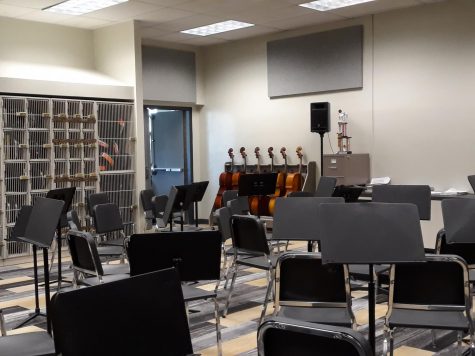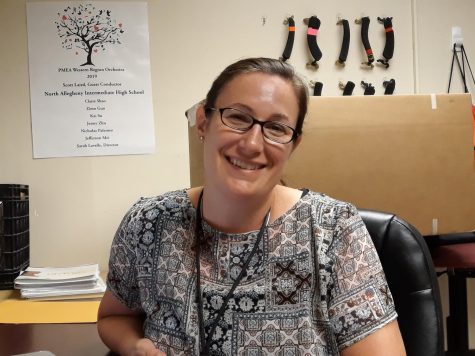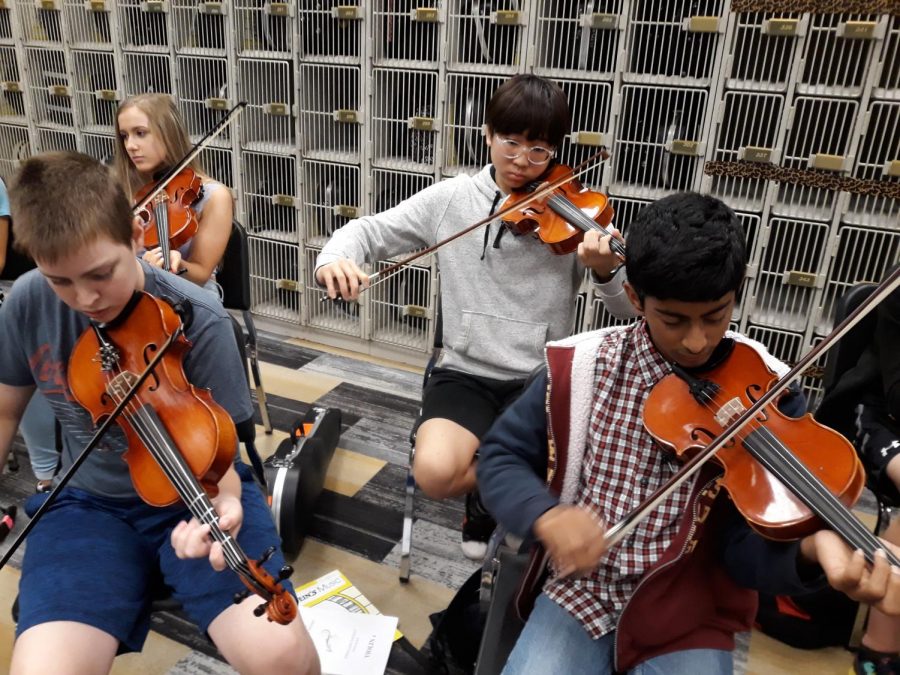Spotlight: NA Orchestra
Violin and viola students play their instruments in 4th period orchestra class.
The different instruments in an orchestra combine to create a singular melody, but it’s important to recognize the individual moments that make up that elegant sound. It is certainly one of the advantages of being part of a large school district, but the sheer number of orchestra students at North Allegheny allows the district to be able to offer many unique music opportunities for its students, some of which are rarely found state-wide.

The size of the NA orchestra is truly unprecedented, with twelve full-time teachers servicing the more than 1700 students that play a string instrument in the district. To get a better sense of the orchestra program at North Allegheny, NAEye spoke with Mrs. Lavelle, who teaches orchestra classes at both NAI and NASH. “I started here in 2006, and between NASH and NAI, there were about 200 kids in the high school orchestra program, and now there are almost 400,” she says. Out of the more than 1700 orchestra students district-wide, there are 212 string students at NAI this year. “My guess is that it’s probably the biggest orchestra program in Pittsburgh,” said Mrs. Lavelle.
The orchestra sometimes takes a backseat to the band program at NA, yet its place in the schools is second to none in its importance in the well-rounded mental development of students. “Kids are drawn to different instruments and their varying timbres and sounds, and it’s great to be able to serve the whole population,” said Mrs. Lavelle. To the merit of the district, this balanced music program has been awarded the National Association of Music Merchants Foundation’s Best Communities for Music Education Award for the past thirteen consecutive years. Further commenting on the uniqueness of string music, Mrs. Lavelle stated that “there are just some really unique challenges and fun things string instruments are able to do.”
The Golden Strolling Strings is a component of the NA orchestra that can only be found in a few schools across the country. For those not familiar, the Strolling Strings is just what it sounds like – string students memorize music that can be performed while walking around a room. Playing at various events around the local area, the Strolling Strings has been in existence for over 30 years. Nearly 100 orchestra students playing the same song by memory as they circle the room is truly a sensory experience that needs to be seen to be believed, as orchestra music is typically only seen in an on-stage format. “I’ve heard of two others in the state; it’s pretty unusual,” Mrs. Lavelle mentions.
An additional music program offered to North Allegheny string students is the NA Fiddlers, led by McKnight Elementary orchestra teacher Dennis Morton. Since 2002, the NA Fiddlers have been holding a week-long summer workshop where the students learn various songs by ear, or without any sheet music. After the workshop, the group then brings its old-time Appalachian fiddle tunes to a variety of institutions around the Pittsburgh area. Although the fiddlers meet entirely outside of school, it is still a great opportunity for those wanting a more relaxed experience with their instrument, and everyone learns some local music history in the process.

We are lucky to be in a district that values music, as unlike some other schools, the orchestra program has remained steadfast in its placement at NA. Mrs. Lavelle was also able to provide insight into the background of being an orchestra teacher, saying, “I think what’s most important is kids getting that experience of working together, creating something together, making music together,” which is very much at the core of any instrumental group. We can hope that the North Allegheny orchestra remains a strong part of the school district in the future, but we must also remain supportive of all aspects of the instrumental music program at North Allegheny. With proper support, these programs can remain to provide beautiful music for decades to come.

Andrew McLaughlin is a ninth-grader at North Allegheny Intermediate. He formerly was the editor on the student newspaper at Carson Middle School and enjoys...


